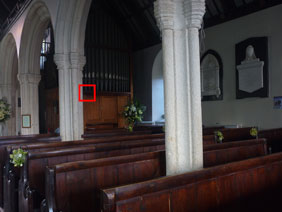Panasonic Lumix DMC-FT1 / TS1
-
-
Written by Gordon Laing
Panasonic Lumix DMC-FT1 / TS1 vs Canon PowerShot D10 vs Olympus TOUGH 8000 High ISO noise
|
 | To compare noise levels under real-life conditions we shot this scene with the Panasonic Lumix DMC-FT1 / TS1, Canon PowerShot D10 and the Olympus TOUGH 8000 within a few moments of each other using each of their ISO settings. The lenses were set to approximate the same field of view. |
The above shot was taken with the Panasonic Lumix DMC-FT1 / TS1 in Program mode with the lens zoomed in slightly to 6mm. The exposure was one second at f3.7. The crops are taken from the area marked with the red square and presented below at 100%.
With one exception, the Panasonic Lumix DMC-FT1 / TS1 performs very well throughout the ISO range, striking a good balance between reducing noise and maintaining image detail. At 80 and 100 ISO you’d have to look very hard to find any evidence of noise and at 200 ISO the noise just begins to become apparent as a slight granularity, but nothing that most people are going to notice.
At 400 ISO though we’re into real noise territory. As you’d expect, there’s noise here and there’s no mistaking it. But it is sensibly dealt with by the FT1 / TS1’s noise reduction filters producing a result that maintains good image detail. At 800 ISO, where you often see a significant jump in the amount of noise, things are only a little worse. It’s not until we reach 1600 ISO that things really start to fall apart, with a big hike in the amount of visible noise, a very noticeable deterioration in image quality and colour balance that’s gone off the rails.
There’s little to choose between the Panasonic Lumix DMC-FT1 / TS1 and Canon PowerShot D10 in terms of noise. Both do an excellent job at the lower ISO levels and, somewhat surprisingly, both lose their way with colour balance further up the range – sooner in Canon’s case at 800 ISO. It would be fair to say that where it matters – in the 80 – 400 ISO range they both do an excellent job. Beyond that, no compact is going to produce a great result, but a noisy photo is better than no photo at all. You could also argue a noisy photo is better than a noisy photo with poor colour balance and the failure of both cameras in this respect is a little disappointing.
The Olympus TOUGH 8000 shows no evidence of noise up to and including the 200 ISO shot. This is perhaps not surprising given the overall softness of the images and the fact that the 64 and 100 ISO shots were underexposed due to the camera not being able to select a shutter speed slower than 0.5s in Program mode. From 400 ISO up the Olympus images display much more noise than either of the other two cameras, so again another disappointing result from the best-seller. The new kids on the (underwater) block are certainly showing the established player a thing or two here.
Now head over to our Panasonic Lumix DMC-FT1 / TS1 Gallery to see some more real-life shots in a variety of conditions.
Panasonic Lumix DMC-FT1 / TS1 |
Canon PowerShot D10 |
Olympus TOUGH 8000 | ||
 |  |  | ||
80 ISO |
80 ISO |
64 ISO | ||
 |  |  | ||
100 ISO |
100 ISO |
100 ISO | ||
 |  |  | ||
200 ISO |
200 ISO |
200 ISO | ||
 |  |  | ||
400 ISO |
400 ISO |
400 ISO | ||
 |  |  | ||
800 ISO |
800 ISO |
800 ISO | ||
 |  |  | ||
1600 ISO |
1600 ISO |
1600 ISO | ||
 |  | |||
3200 ISO (1600×1200) |
3200 ISO (2048×1536) |
3200 ISO (not available) |





